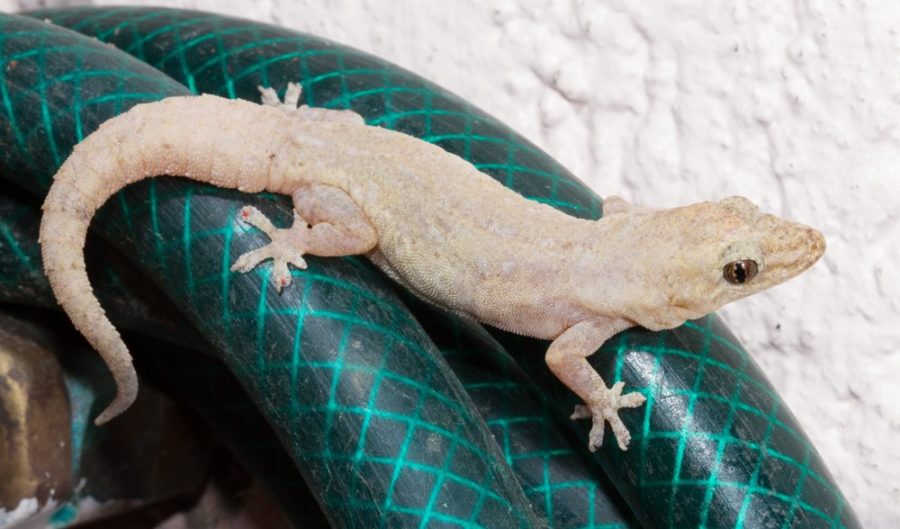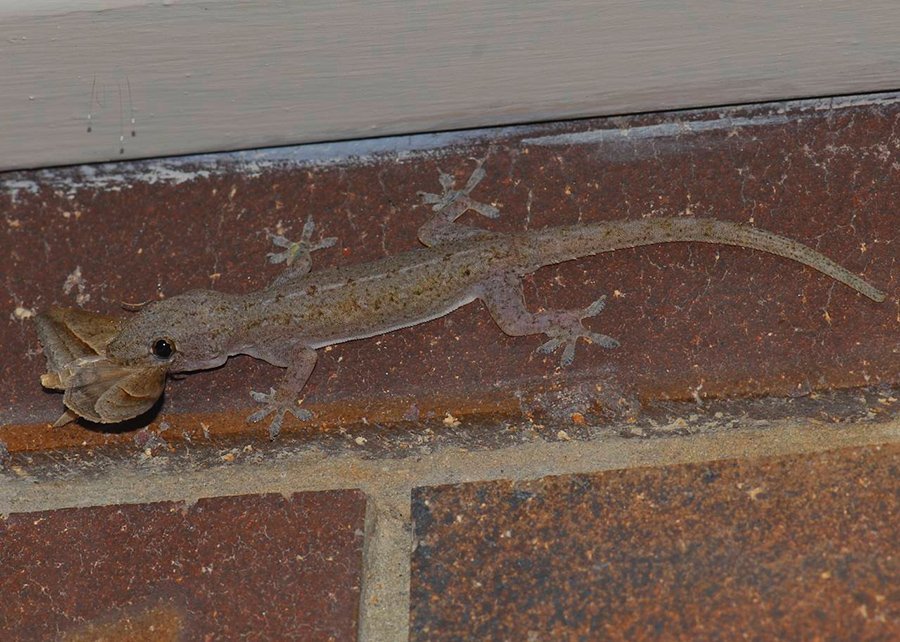Asian house geckos: to love them or hate them?

Known for their high level of vocalness, Asian house geckos (Hemidactylus frenatus) are a tiny, introduced species of lizard that have a loud, distinctive call of ‘chuck, chuck, chuck’ – one of the few ways they’re distinguishable from our native geckos.
Despite being relatively cute, the Asian house gecko divides opinions across Australia. Native to South and South-East Asia, these small geckos were originally tree dwellers, but have found a new habitat in which to thrive – our homes and buildings.
Successful Stowaways
Asian house geckos generally reach up to about 11cm in size, making them seriously successful stowaways. Almost identical to our native geckos, they can be identified by the spines found running down either side of their tails.
Tucked in amongst cargo on container ships, these tiny reptiles have accidently hitch-hiked their way across the globe and now have the broadest distribution of any lizard in the world.
See more: A new species of gecko has been discovered and it has golden eyes
Their success in spreading is due largely to the nature of their eggs. While most reptiles lay eggs with soft, parchment-like shells that dehydrate rapidly in dry conditions, the Asian house gecko lays round, hard-shelled eggs which are much more resistant to moisture loss.
On top of this females are capable of storing sperm for up to 12 months at a time, making a single female capable of founding a new population.
Over the last half century, the Asian house gecko has spread in great numbers largely throughout Queensland and the Northern Territory. But their impact is still unclear.

Asian house gecko (Image Credit: Stewart Macdonald)
Ask an expert
Asian house gecko expert, Dr Louise Barnett spoke to Australian Geographic about the potential effect of these increasingly common reptiles.
“Asian house geckos have been in Australia since the 1960s, but no one’s really paid them that much attention because everyone just assumed they were restricted to houses,” said Louise.
Difficult to distinguish from native geckos, Asian house geckos’ unassuming manner and ability to camouflage has helped them go unnoticed.
“A lot of people see them in their houses and they think ‘it’s just a white little gecko’ and then they go out into the bush and see a brown gecko and think it’s a native gecko. But actually Asian house geckos can change their colour. When placed on a brown or white surface, they can rapidly change colour to match.”
According to Louise, geckos have adapted their hunting abilities, giving them a competitive edge over their native counterparts.
While native geckos are more likely to stay out of sight when hunting, darting out of the shadows to catch nearby prey, the Asian gecko has no such qualms about being seen. Asian geckos often rest in brightly lit areas, relying on immobility to go unnoticed by their prey.
“There’s been a bit of research that’s shown these geckos are more likely to forage around lights, so they’ll hunt insects around lights, whereas native geckos tend to be more wary of lights,’ said Louise.
This has led many researchers to believe that Asian geckos outmuscle native geckos in homes, diminishing their food supply and encroaching on their habitat.
See more: Australia’s legless geckos
But homes are not the only places Asian house geckos can thrive. Increasingly found in our native bushland, the effect of these tiny lizards may be more serious than previously thought. Louise has discovered that these geckos can thrive not only in our homes, but in our bushland as well.
“In the places we looked, they were much more abundant than native geckos in the bush – with populations that were more than twice as large in some areas.”
Asian house geckos have introduced two species of mite into Australia and although these mites have not been found to affect our native geckos, Asian house geckos have the ability to host a native Australian parasite, placing their impact on native wildlife under scrutiny.
“If Asian house geckos are a viable host for native parasites, and they live in quite high densities in the bush, then it’s possible that these native parasites will increase in number. More native parasites could then infect native hosts and have a detrimental effect on populations of native species. However, we need more research to understand if this is actually happening and what the impact on our native species is,” said Louise.
As these parasites have a complex life cycle and use more than one type of animal as a host, an increase in their number could impact on a number of different species – like snakes and invertebrates – not just geckos.

(Image Credit: Stewart Macdonald)
So should we love them or hate them?
The long term effects of these geckos in Australia are somewhat unclear. While many people would like to see them eradicated, others don’t mind sharing their living space with these tiny guests.
Louise advocates for a middle ground approach – so long as it’s not at the expense of our native geckos.
“I think they’re cute and they eat the insects from our homes. So, in houses, I think we’ve got to learn to love them, but I would hate for them get further out into the bush and affect our native geckos which are so unique.”

